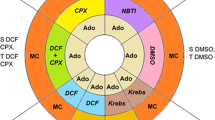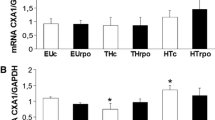Abstract
In order to examine the regulatory role of thyroid hormone on sarcolemmal Ca2+-channels, Na+−Ca2+ exchange and Ca2+-pump as well as heart function, the effects of hypothyroidism and hyperthyroidism on rat heart performance and sarcolemmal Ca2+-handling were studied. Hyperthyroid rats showed higher values for heart rate (HR), maximal rates of ventricular pressure development+(dP/dt)max and pressure fall−(dP/dt)max, but shorter time to peak ventricular pressure (TPVP) and contraction time (CT) when compared with euthyroid rats. The left ventricular systolic pressure (LVSP) and left ventricular end-diastolic pressure (LVEDP), as well as aortic systolic and diastolic pressures (ASP and ADP, respectively) were not significantly altered. Hypothyroid rats exhibited decreased values of LVSP, HR, ASP, ADP, +(dP/dt)max and −(dP/dt)max but higher CT when compared with euthyroid rats; the values of LVEDP and TPVP were not changed. Studies with isolated-perfused hearts showed that while hypothyroidism did not modulate the inotropic response to extracellular Ca2+ and Ca2+ channel blocker verapamil, hyperthyroidism increased sensitivity to Ca2+ and decreased sensitivity to verapamil in comparison to euthyroid hearts. Studies of [3H]-nitrendipine binding with purified cardiac sarcolemmal membrane revealed decreased number of high affinity binding sites (Bmax) without any change in the dissociation constant for receptor-ligand complex (Kd) in the hyperthyroid group when compared with euthyroid sarcolemma; hypothyroidism had no effect on these parameters. The activities of sarcolemmal Ca2+-stimulated ATPase, ATP-dependent Ca2+ uptake and ouabain-sensitive Na+−K+ ATPase were decreased whereas the Mg2+-ATPase activity was increased in hypothyroid hearts. On the other hand, sarcolemmal membranes from hyperthyroid samples exhibited increased ouabain-sensitive Na+−K+ ATPase activity, whereas Ca2+-stimulated ATPase, ATP-dependent Ca2+ uptake, and Mg2+-ATPase activities were unchanged. The Vmax and Ka for Ca2+ of cardiac sarcolemmal Na+−Ca2+ exchange were not altered in both hyperthyroid and hypothyroid states. These results indicate that the status of sarcolemmal Ca2+-transport processes is regulated by thyroid hormones and the modification of Ca2+-fluxes across the sarcolemmal membrane may play a crucial role in the development of thyroid state-dependent contractile changes in the heart.
Similar content being viewed by others
References
Buccino RA, Spann JF Jr, Pool PE, Sonnenblick EH, Braunwald E: Influence of the thyroid state on the intrinsic contractile properties and energy stores of the myocardium. J Clin Invest 46: 1669–1682, 1967
Gay RG, Raya TE, Lancaster LD, Lee RW, Morkin E, Goldman S: Effects of thyroid state on venous compliance and left ventricular performance in rats. Am J Physiol 254: H81-H88, 1988
Strauer BE, Schulze W: Experimental hypothyroidism: Depression of myocardial contractile function and hemodynamics and their reversibility by substitution with thyroid hormones. Basic Res Cardiol 71: 624–644, 1976
Guarneri T, Filburn CR, Beard ES, Lakatta EG: Enhanced contractile response and protein kinase activation to threshold levels of β-adrenergic stimulation in hyperthyroid rat heart. J Clin Invest 65: 861–868, 1980
Limas CJ: Calcium transport ATPase of cardiac sarcoplasmic reticulum in experimental hyperthyroidism. Am J Physiol 235: H745-H751, 1978
Morkin E, Flink IL, Goldman S: Myosin isozymes in cardiac hypertrophy. In: Myocardial Hypertrophy and Failure. Persp Cardiovasc Res 7: 393–404, ed. N.R. Alpert, Raven Press, New York, 1983
Suko J: The calcium pump of cardiac sarcoplasmic reticulum. Functional alterations at different levels of thyroid state in rabbits. J Physiol 228: 563–582, 1973
Takacs IE, Nosztray K, Szabo J, Szentmiklos AJ, Cseppento A, Szegi J: Alterations of contractility and sarcoplasmic reticulum function of rat heart in experimental hypo- and hyperthyroidism. Gen Physiol Biophys 4: 271–278, 1985
Rovetto MJ, Hjalmarson AC, Morgan HE, Barrett MJ, Goldstein RA: Hormonal control of cardiac myosin adenosine triphosphatase in the rat. Circ Res 397–409, 1972
Conway G, Heazlitt RA, Fowler NO, Gabel M, Green S: The effect of hyperthyroidism on the sarcoplasmic reticulum and myosin ATPase of dog heart. J Mol Cell Cardiol 8: 39–51, 1976
Sharp NA, Neel DS, Parsons RL: Influence of thyroid hormone level on the electrical and mechanical properties of rabbit papillary muscle. J Mol Cell Cardiol 17: 119–132, 1985
Takacs I, Meszaros J, Szegi J: Effect of induced hyperthyroid state on the mechanical and electrical properties of the rat ventricular myocardium. Acta Physiol Hung 64: 163–171, 1984
Seppet EK, Kadaya LY, Hata T, Kellikorm AP, Saks VA, Vetter R, Dhalla NS: Thyroid control over membrane processes in rat heart. Am J Physiol 26 (Suppl): 66–71, 1991
Kim D, Smith TS: Effects of thyroid hormones on calcium handling in cultured chick ventricular cells. J Physiol (Lond) 364: 131–149, 1985
Beckett PR: The isolated perfused heart preparation: two suggested improvements. J Pharm Pharmacol 22: 818–822, 1970
Fulton RM, Hutchinson RM, Jones AM: Ventricular weight in cardiac hypertrophy. Brit Heart J 14: 413–420, 1952
Pitts BJR: Stoichiometry of sodium-calcium exchange in cardiac sarcolemmal vesicles. J Biol Chem 254: 6232–6235, 1979
Lowry OH, Rosenbrough NJ, Farr AL: Protein measurement with Folin reagent. J Biol Chem 193: 265–275, 1951
Taussky HH, Shorr E: A microcolorimetric method for the determination of inorganic phosphorus. J Biol Chem 202: 675–685, 1953
Hata T, Makino N, Nakanishi N, Yanaga T: Modulation of Na+−Ca2+ exchange in cardiac sarcolemmal vesicles by Ca2+ antagonists. Mol Cell Biochem 84: 65–76, 1988
Makino N, Dhurubarajan R, Elimban RE, Dhalla NS: Alterations of sarcolemmal Na+−Ca2+ exchange in catecholamine-induced cardiomyopathy. Can J Cardiol 1: 225–232, 1985
Philipson KD, Nichimoto AY: Na+−Ca2+ exchange in inside-out cardiac sarcolemmal vesicles. J Biol Chem 257: 5111–5117, 1982
Makino N, Panagia V, Gupta MP, Dhalla NS: Defects in sarcolemmal Ca2+ transport in hearts due to induction of calcium paradox. Circ Res 63: 313–321, 1988
Matucci R, Bennardini F, Sciamarella ML, Baccaro C, Stendardi I, Franconi F, Siotti A: [3H]-nitrendipine binding in membrane obtained from hypoxic and reoxygenated heart. Biochem Pharmacol 36: 1059–1062, 1987
Wagner JA, Reynolds IJ, Weisman HF, Dudeck P, Weisfeldt ML, Snyder SH: Calcium antagonist receptors in cardiomypathic hamster: selective increases in heart, muscle, brain. Science 232: 515–518, 1986
Munson PJ, Robard D: Ligand: a versatile computerized approach for characterization of ligand-binding systems. Anal Biochem 107: 220–239, 1980
Daly MJ, Dhalla NS: Sarcolemmal Na+−K+ ATPase activity in hypothyroid rat heart. J Appl Cardiol 2: 105–119, 1987
Seppet EK, Adoyaa AJ, Kallikorm AP, Chernousova SB, Lyulina NV, Sharov VG, Severin VV, Popovich MI, Saks VA: Hormone regulation of cardiac energy metabolism. Creatine transport across cell membranes of euthyroid and hyperthyroid rat heart. Biochem Med 34: 267–279, 1985
Marcus RH, Butkow N, Wheatley AM, Lippe I, Norton G, Rosendorff C: Independent mechanisms for the chronotropic and inotropic responses in hyperthyroidism. Basic Res Cardiol 82: 261–270, 1987
Daly MJ, Seppet EK, Vetter R, Dhalla NS: Membrane abnormalities and changes in cardiac cations due to alterations in thyroid status. In: Subcellular Basis of Contractile Failure, Korecky B, Dhalla NS, eds. Kluwer Academic Publishers, (Chapter 11) pp. 173–191, 1990
Bilezikian JP, Loeb JN: The influence of hyperthyroidism and hypothyroidism on α- and β-adrenergic receptor systems and adrenergic responsiveness. Endocrinol Rev 4: 378–388, 1983
Flokerzi V, Ruth P, Oeken J, Jung B, Hofman F: The cardiac calcium channel: properties and regulation. Horm Cell Regulation 139: 235–248, 1986
Hawthorn MH, Gengo P, Wei X-Y, Rutlege A, Moran JF, Gallant S, Triggle DJ: Effect of thyroid status on α-adrenoceptors and calcium channels in rat cardiac and vascular tissue. Naunyn-Schmiedeberg's Arch Pharmacol 337: 539–544, 1988
Besch HR Jr, Jones LR, Watanabe AM: Intact vesicles of canine cardiac sarcolemma: evidence from vectorial properties of Na+, K+-ATPase. Circ Res 39: 586–595, 1976
Besch HR, Jones LR, Fleming JW, Watanabe AM: Parallel unmasking of latent adenylate cyclase and (Na+, K+)-ATPase activities in cardiac sarcolemmal vesicles. A new use of the channel forming ionophore alamethicin. J Biol Chem 252: 7905–7908, 1977
Bonnafous JC, Dornand J, Mani JC: Detergent-like effects of alamethicin on lymphocyte plasma membranes. Biochem Biophys Res Commun 86: 536–544, 1979
Schuurmans-Stekhoven F, Bonting SL: Transport adenosine triphosphatases: properties and functions. Physiol Rev 61: 2–76, 1981
Philipson KD, Edelman IS: Thyroid hormone control of Na+−K+-ATPase and K+-dependent phosphatase in rat heart. Am J Physiol 232: C196-C201, 1977
Lo CS, Klein LE, Lo TN: Effect of thyroid hormone on carbohydrate content of Na+−K+-adenosine triphosphatase. Am J Physiol 247: C282-C287, 1984
McConnaughey MM, Jones LR, Watanabe AM, Besch HR Jr, Williams LT, Lefkowitz RJ: Thyrosine and propylthiouracil effects on α- and β-adrenergic receptor number, ATPase activities, and sialic acid content of fat cardiac membrane vesicles. J Cardiovasc Pharmacol 1: 609–623, 1979
Beeler TJ, Wang T, Gable K, Lee S: Comparison of the rat microsomal Mg-ATPase of various tissues. Arch Biochem Biophys 243: 644–654, 1985
Zhao D, Dhalla NS: Characterization of rat heart plasma membrane Ca2+/Mg2+ ATPase. Arch Biochem Biophys 263: 281–292, 1988
Cao A, Devirgillis S, Trabalza N, Furbetta M: Serum creatine phosphokinase isoenzymes in congenital hypothyroidism. J Pediatr 78: 134–135, 1971
Peschke E, Peschke D, Ruzsas C, Helwin H: Creatine kinase in hypo- and hyperthyroid rats under consideration of the circadian oscillations. Exp Clin Endocrinol 92: 91–96, 1988
Rudinger A, Mylotte KM, Davis PJ, Davis FB, Blas SD: Rabbit myocardial membrane Ca2+-adenosine triphosphate activity: stimulationin vitro by thyroid hormone. Arch Biochem Biophys 229: 379–385, 1984
Pliam NB, Goldfine ID: High affinity thyroid hormone binding sites on purified rat liver plasma membranes. Biochem Biophys Res Comm 79: 166–172, 1977
Morrow DH, Gaffney TE, Braunwald E: Studies on digitalis: influence of hyper- and hypothyroidism on the myocardial response to ouabain. J Pharmacol Exp Ther 14: 324–328, 1963
Akera T, Brody TM: The role of Na+−K+-ATPase in the inotropic action of digitalis. Pharmacol Rev 29: 187–220, 1978
Fellenius E, Hansen CA, Mjos O, Neely JR: Chronic infarction decreases maximum cardiac work and sensitivity of heart to extracellular calcium. Am J Physiol 249: H80-H87, 1985
Finkel MS, Marks ES, Patterson RE, Speir EH, Steadman KA, Keiser HR: Correlation of changes in cardiac calcium channels with hemodynamics in syrian hamster cardiomyopathy and heart failure. Life Sci 41: 153–159, 1987
Kim D, Smith TW, Marsh JD: Effect of thyroid hormone on slow calcium channel function in cultured chick ventricular cells. J Clin Invest 80: 88–94, 1987
Mylotte KM, Cody V, Davis PJ, Davis FB, Blas SD, Schoeno M: Milrinone and thyroid hormone stimulate myocardial membrane Ca2+-ATPase activity and share structural homologies. Proc Natl Acad Sci USA 82: 7974–7978, 1985
Fabiato A: Calcium-induced release of calcium from the cardiac sarcoplasmic reticulum. Am J Physiol 245: C1-C14, 1983
Daly MJ, Dzurba A, Tuana BS, Dhalla NS: Sarcolemmal Ca2+-binding and enzyme activities in myocardium from hypothyroid rat. Can J Cardiol 2: 356–361, 1986
Mackinnon R, Morgan JP: Influence of the thyroid state on the calcium transient in ventricular muscle. Pflugers Arch 407: 142–144, 1986
Litten RZ III, Martin BJ, Howe ER, Alpert NR, Solaro RJ: Phosphorylation and adenosine triphosphatase activity of myofibrils from thyrotoxic rabbit hearts. Circ Res 48: 498–501, 1981
Skelton CL, Su JU, Pool PE: Influence of hyperthyroidism on glycerol-extracted cardiac muscles from rabbits. Cardiovasc Res 10: 380–384, 1976
Author information
Authors and Affiliations
Rights and permissions
About this article
Cite this article
Seppet, E.K., Kolar, F., Dixon, I.M.C. et al. Regulation of cardiac sarcolemmal Ca2+ channels and Ca2+ transporters by thyroid hormone. Mol Cell Biochem 129, 145–159 (1993). https://doi.org/10.1007/BF00926363
Issue Date:
DOI: https://doi.org/10.1007/BF00926363




